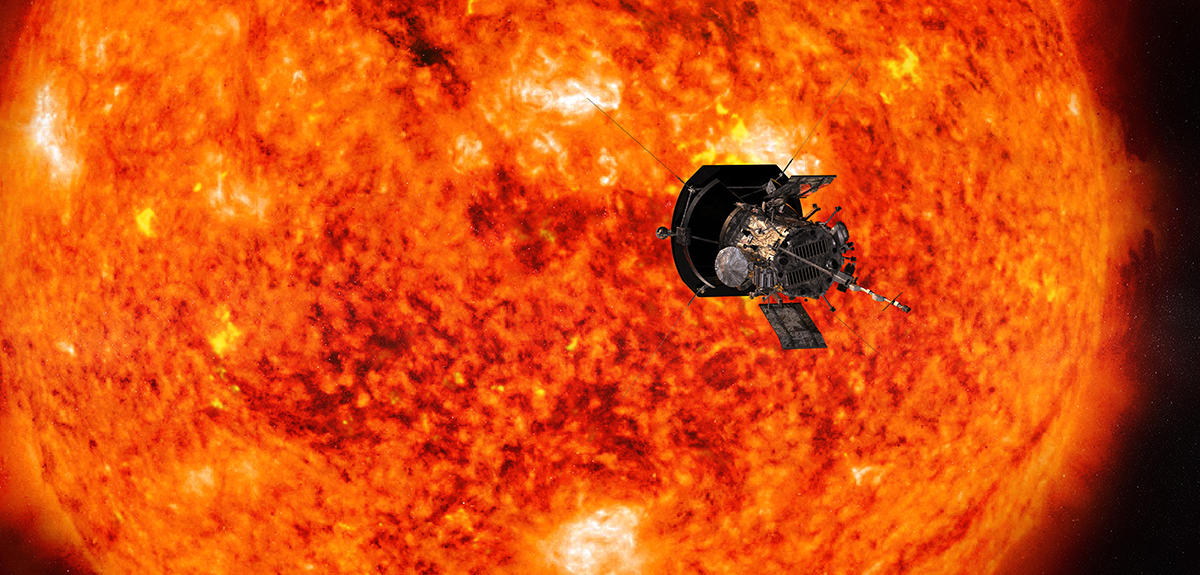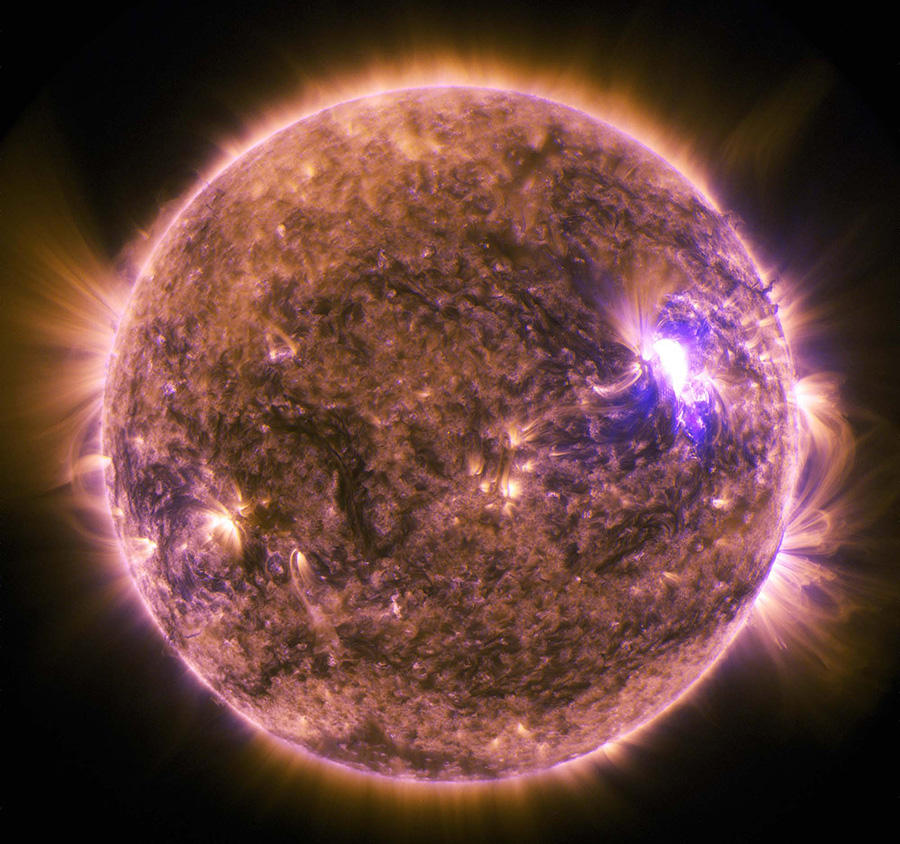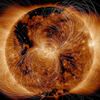You are here
A Mission to Touch the Sun

This is a historic moment. At long last we will be able to take a close look at our benevolent star, without which life on Earth could not exist. For the first time, a probe will be visiting the Sun. Early August, NASA will effectively launch the Parker Solar Probe. The purpose of this bold mission? To plunge into the solar corona, the solar atmosphere that extends several million kilometers from the Sun’s surface to form the white halo visible in images of eclipses. A scientific version of the film Sunshine, in which astronauts brave the fiery furnace of the Sun to re-energize its dying thermonuclear reactions?
Heat shield
The probe will advance cautiously towards the Sun. After an initial close pass in the fall, it will complete a series of elliptical revolutions, the closest of which will be 6 million kilometers (a mere 8.8 solar radiiFermera distance equivalent to the radius of the Sun, a unit of length commonly used to express the size of stars.) from the surface. Here, it will be perfectly positioned to solve two of the greatest mysteries of astrophysics. The four on-board instrumental suites, to which several CNRS-affiliated laboratories have contributed,1 will in effect provide unprecedented data, first about the solar wind plasma, with electromagnetic fields and particles of which the corona is made, and second, about the origin of solar wind. The mission will thus mark a new page in space exploration, on par with the flyby of the giant planets by the Voyager probes in the 1970s and the landing on a comet by Rosetta’s probe Philae in 2016.
A mission to the Sun? “About time!” it is tempting to retort. Sending a pioneer satellite to the heart of the Solar System has been viewed as a necessity since the dawn of the Space Age. Such a mission in fact was among the projects tabled by Simpson’s Committee which, at the end of the 1950s, drew up a list of US space objectives. It has remained a priority for space agencies over the ensuing 40 years, but has so far been prevented by one obstacle: the colossal heat of the Sun. Even at a distance of several times the Sun’s radius, the radiation emitted is still some 600 times greater than what we would get sitting on a beach here on Earth. Such levels of radiation are enough to melt any ordinary material.

To avoid getting its wings burnt, the probe will be equipped with an ultra-resistant heat shield. “This mission has been made possible by the development of composite materials similar to those used in the noses of space shuttles and based on a carbon-ceramic composite,” explains Milan Maksimovic, of the LESIA2 in Meudon and one of the mission coordinators. Parker Solar Probe is the size of a small car and looks like a dancer with its telescopic arm and its flared section reminiscent of a skirt. The shield, which is 11 cm thick, is positioned below the latter section and will protect the satellite throughout each of its 25 passes near the Sun, with the closest approach scheduled for 2024. Throughout this entire period, the probe will be powered by solar panels, which will be protected by the shield during the weeks of strongest radiation.
A corona’s enigma
Just a few short weeks before countdown, Milan Maksimovic is delighted to finally see this long-term project coming to fruition: “Until now, everything we know about the Sun is based entirely on studies conducted remotely, in particular thanks to the SOHO satellite.3 With Parker Solar Probe, for the very first time we will have access to readings made in situ.” The data should shed light on one mystery that has been puzzling physicists since its discovery in the 1940s.
“The probe will help us to understand one of the Sun’s deepest secrets: how the corona gets its heat,” comments Thierry Dudok de Wit, of the LPC2E4 in Orléans. “The temperature at the Sun’s surface is 6000°C but as we move away from the surface, it rises to several million degrees. It’s as though the air gets hotter as you step back from a chimney!” The mission is in fact named in honor of US theoretical physicist, Eugene Parker, one of the first scientists to have investigated this strange phenomenon.



The LPC2E has manufactured one of the magnetic field sensors that will be used to test current theories about superheating of the corona. According to one hypothesis, the extreme temperatures result from the effects of electromagnetic waves, just as an induction cooker heats a saucepan. But they could just as easily be caused by numerous small solar eruptions not visible from Earth. In this scenario, the ejected matter heats up the atmosphere following a series of complex phenomena involving rapid reconfigurations of magnetic field lines, as if the latter were agitating and exciting the environment. Tell-tale signs of either of these mechanisms should be apparent in the recorded signals. The LPC2E sensor is situated at the end of the telescopic arm, well away from any electromagnetic disturbance coming from the satellite itself.

Like the shield, the instruments onboard the probe have also undergone extensive heat-resistance testing. While they will not all be directly exposed to the Sun’s light, they will nevertheless be subjected to extreme temperature variations during the successive orbits. Part of the thermal testing was carried out in a giant solar furnace—the size of the Arc de Triomphe—located at Odeillo in the Pyrenees region of France, under the aegis of the PROMES5 of the CNRS.
“Thanks to the solar furnace and our test equipment, ours is the only team in the world able to test Parker Solar Probe’s equipment down to the last detail and under conditions comparable to those encountered near the Sun,” proudly points out Marianne Balat-Pichelin, assistant director of the laboratory. “By focusing solar light inside a vacuum chamber, it is possible to heat a large object to more than 2000°C, exactly as if it were in space!” In particular, these tests led to a drastic decision concerning the type of tungsten used to manufacture the particle sensor in the probe. This device will provide additional clues to help understand both the heating process and the harmful effects of the Sun.

The mystery of solar wind
On March 13, 1989 in Québec, a geomagnetic storm caused an electrical power blackout. For nine hours, the entire region went dark. This phenomenon was caused by a huge gust of solar wind colliding with Earth. Solar wind consists of plasma (made up of 95% protons, a few percent helium nuclei and a residue of heavy ions, carbon and iron) ejected from the corona and which travels through space at a speed of between 200 and 800 kilometers per second. In 1859, one such surge created such disturbance in the Earth’s magnetic field that polar auroras were visible from the Caribbean. In the United States, the sky was so bright that it was possible to read a newspaper in Boston in the middle of the night. The source of the solar wind and of such irregular events is the other great mystery that will be investigated by Parker Solar Probe.
Physicists in fact do not know why the Sun, as it exhales the solar wind, is suddenly shaken by violent coughing fits. Although since the events of 1989, electricity suppliers have learned to brace against such geomagnetic accidents, magnetic storms continue to pose a certain risk to society: for instance, they distort GPS data and could disrupt the orbit of satellites. Solar storms occur once a year on average. A particularly violent disturbance could bring down the Internet or cause a collision between airliners due to GPS signal errors.
Although Parker Solar Probe is primarily a fundamental research tool, the data collected should help provide a better understanding of such threats. But “studying the solar wind is also of interest for planetology,” notes Milan Maksimovic. “Planets, comets and asteroids are all affected by it. The surface of the Moon, which was initially solid, has been gradually eroded by solar wind. It was solar wind that stripped away the atmosphere of Mars, resulting in evaporation of the red planet’s oceans and the extinction of any life that might have once existed there.”
How does the corona create the slowest solar wind? Some theories suggest the key lies in dynamic magnetic field lines that form a glowing mane at the surface of the Sun. As these lines—like highways for particles—fall back towards the surface, they cause the famous coronal loops, the gigantic neon arches seen glowing in photographs. Loop material is traditionally thought to be confined to the corona but the last decades of research suggest this material could also contribute to the winds blowing in the direction of our own planet.

“We know that the loops have similar composition as the slowest solar wind,” explains Alexis Rouillard, a coronal dynamics specialist with the IRAP6 in Toulouse. “Perhaps there is some mechanism that causes the loops to open up and release matter into space.” Rouillard made scientific contributions to the wide-angle camera on board the satellite that will generate images which, by establishing a link between the loop dynamics and the plasma escaping in the solar wind, should provide a clearer understanding of the processes at play.
Sonic booms
What about the gusts responsible for magnetic storms? These gusts appear to be a solar version of the sonic booms created by supersonic aircraft. According to the main hypothesis, high-speed shock waves on which the wind particles ride regularly travel through the corona, and this mechanism accelerates packets of particles. “If we find high-energy particles streaming out of these shock waves, whose existence is now beyond doubt, this will be a strong indication that the waves play a central role in the process of high-energy particle acceleration,” claims Rouillard.
Parker Solar Probe will complement such analyses by providing entirely new 3-D images of the electron clouds that accompany gusts of solar wind. “These particles, which are highly reactive to fluctuations in the interplanetary electromagnetic field, play a key role in the creation of solar wind, although we still don’t know exactly how,” adds Matthieu Berthomier, whose team designed the extremely energy-efficient integrated electron detection circuit at the LPP.7 “We are the only team to manufacture this type of circuit, which will also be used in the European Solar Orbiter mission due to head out towards the Sun in 2020.” Solar Orbiter shares a number of objectives with its American sibling, but being stationed further from the Sun, at 70 solar radii, it will focus more particularly on how solar disturbances affect the Earth.
For the moment, however, Berthomier’s eyes are sharply set on Cape Canaveral, where the probe is to be launched on August 4th. Further proof that Parker is an extraordinary mission is provided by the last-minute modifications being made to the probe, an extremely unusual procedure within the space industry so near to the scheduled launch time (changes were made to the internal monitors used to indicate any sudden temperature increases within the probe itself). “This is another of the things that make this mission so exciting: we are really outside our comfort zone, just like we were with the Rosetta mission,” exclaims Thierry Dudok de Wit enthusiastically. “We are taking risks, but I am certain that our pursuit of the unknown will pay off.” For countless millennia, the Sun has been venerated by human civilizations. With Parker Solar Probe, we will finally touch it.
- 1. The five CNRS-affiliated laboratories implicated in the mission Parker Solar Probe, with financial backing from Cnes are: Institut de recherche en astrophysique et planétologie (IRAP), Laboratoire d'études spatiales et d'instrumentation en astrophysique (LESIA), Laboratoire de physique et chimie de l’environnement et de l’espace (LPC2E), e Laboratoire de physique des plasmas (LPP) and laboratoire Procédés, matériaux et énergie solaire (PROMES).
- 2. Laboratoire d'études spatiales et d'instrumentation en astrophysique (CNRS Unit/ Paris Observatory/University of Paris-Diderot/Sorbonne University/University of Versailles-Saint-Quentin/Cnes).
- 3. Launched in 1995 by CNES and NASA and still in operation, SOHO (the Solar and Heliospheric Observatory) has completely revolutionized our knowledge of the Sun. It travels in a halo orbit around a point situated 1.5 million kilometers from Earth in the direction of the Sun.
- 4. Laboratoire de physique et chimie de l’environnement et de l’espace (CNRS unit /CNES/University of Orléans).
- 5. Laboratoire Procédés, matériaux et énergie solaire (CNRS unit affiliated with the University of Perpignan via Domitia).
- 6. Institut de recherche en astrophysique et planétologie (CNRS Unit /University of Toulouse Paul-Sabatier).
- 7. Laboratoire de physique des plasmas (CNRS Unit /École Polytechnique/Paris Observatory/University of Paris-Sud/Sorbonne University).
Explore more
Author
With a PhD in physics, Xavier Müller is a science journalist. Since 2008, he has also published several novels.


















